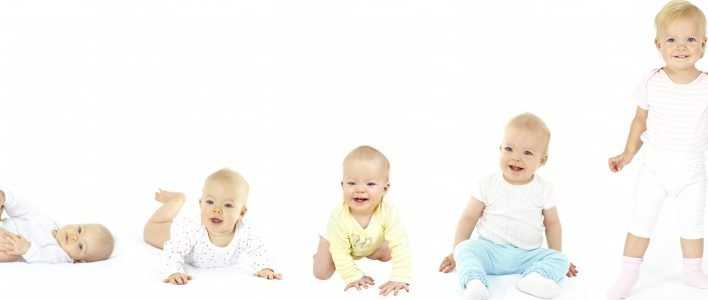Development calendar of the baby after the birth

- Since Baby makes in the first year of life through typical development phases whose temporal dispersion increases with age. However, development deficits can be compensated or made up for at short notice.
- Conspicuous or long-term deficits are treated in pediatrics. To detect such actual developmental delays early, there are child care examinations.
- After 3 to a maximum of 5 months, the weight of a healthy baby has doubled and it has grown by about 15 cm. Ten kilograms and 75 cm are expected at the end of the first year of life, which is about three times the birth weight.
1. The developmental stages of an infant proceed in a particular order
Every child has its own pace of development
A bar for the newborn child should definitely not be the development calendar. Here is always: Everything in his time. Each child has its own pace of development. Rather, look forward to every progress your child makes.
The first 12 months in your baby’s life are a fast-paced time. Almost daily, your child learns new skills and accumulates many experiences that enable him to crawl, walk, and speak.
In most cases, the Milestones in child development in this order:
- Lifting the head
- To grab
- Turn in both directions
- Sit
- seals
- Crawl
- Stand
- To run
This order is not set in stone. In rare cases, children may skip crawling and start standing and running right after the seal.
1.1 It is worth recording the child’s development on paper
If you want to capture the milestones in your baby’s development, you can find a PDF to print here. For girls there is the same PDF to fill in pink.
Of course, in the digital age, there are also various apps that you can use to capture your child’s development. Here you can download a corresponding app.
2. The first trimester in the baby development calendar is making rapid progress

Targeted grasping is often the first milestone in the development of a baby.
For the first 4 weeks, fingers are held, the mother‘s voice recognized and the chest searched. In the second month, the baby becomes more active. It begins to perceive objects and sounds more clearly. From time to time there is also a smile for the proud parents.
It takes 3 months for the infant to more and more try to contact its environment: Turning to him, the offspring might smile. He is now following his mom and dad gradually with his eyes.
The child looks in the direction of a noise source, if it is interesting enough and using different sounds will be talking to mom and dad cooing.
In addition, babies usually start at this age, to reach for objects and try to put them in your mouth, which usually does not quite work that way.
To roll on the stomach on its own is not possible at this age, but the offspring can keep his head up longer and try to lean on his forearms.
The training of the neck muscles and the back takes place for the most part while fidgeting on the blanket. If the baby is lying on his back, it always angles more and more to the legs. This is an important point in the baby‘s development calendar and is a precursor to sitting.
Between the 3rd and 4th month, the time has come for the next screening appointment with the pediatrician. This is the U4 exam, which provides an overview of the child’s hearing, vision, and motor development.
3. In the second trimester of the baby development calendar, a significant increase in mobility is expected

The support on the forearms and the angling of the legs are an important prerequisite for crawling.
In the 4th month it is becoming more and more common for the baby to explore his environment, reach for things and try to put them in his mouth. In the 5th month there is a possible danger of falling, because the child is trying to turn himself. In addition, the baby’s interest in his environment increases manyfold.
6 months are now reached and the mobility of the baby increases significantly, it also responds to your speech with sounds and can see three-dimensional.
The conversations with the offspring are now becoming more intense. The child constantly repeats individual syllables and begins to understand the meaning of certain words.
Through posture, locomotion and through sounds the baby shows you if it needs support. If parents strengthen their child in this phase and give him security, they will soon be more likely to explore the world.
Lying on his stomach, the baby leans on his stretched arms, develops the three-dimensional vision and thus learns to estimate distances.
Maybe your baby can already turn in both directions, if not, that’s not bad either. The age at which babies learn to rotate, sit or crawl varies considerably.
Sometimes children can already walk with 10 months. Others take twice as long. However, the order of learning is usually the same: First comes the turn from the abdominal to the supine position and vice versa, then sitting, crawling and finally running.
If your child is chewing on things, producing a lot of saliva and is very whiny, maybe the first teeth will start.
Caution: The more mobile your baby becomes, the more important it becomes that it is never left alone where there is a risk of falling. Although the spatial perception of infants is sufficient to recognize that an abyss is dangerous, it still can not adequately control its movements and can not correctly assess the danger.
Here is a table of childhood development between 1 and 6 months of age.
4. The third trimester in the baby’s development calendar is accompanied by strangling and crawling

As soon as the baby begins to crawl, special care needs to be taken.
From the 7th month, most children start crawling and try to imitate language. Maybe your child starts to stare (shy away from parents or familiar faces). In the 8th month, sitting works better and better.
From 9 months, it can happen that some children are already pulling up on furniture or their parents, to stand and hold on. If the child is held by the hands, it may stand for a few seconds with all the weight on the legs. It also prepares to start running.
Avoid the use of walking aids, because some experts even consider these harmful. Let your child learn at his own pace.
Some children already know the tweezers grip at this age. In this case, for example, crumbs are lifted between the fingertips of the extended thumb and index finger.
Many babies now also develop a great fondness for playing hide-and-seek. No sooner are mum or dad gone than they are looking for a hiding place. Many babies are less and less fixed on the mother, dad is more important as a play partner.
5. The fourth trimester of the baby development calendar is about learning how to walk and talk

It is a special moment for the parents when the child takes the first steps.
In the 10th month, sitting rarely causes problems and children explore the faces of their fellow human beings. In the 11th month, babies still often over-grasp, but gripping succeeds better and better. Running and speaking attempts are progressing.
The first birthday has been reached and the baby has become a toddler. Now most children in the state can keep their balance well. When walking by the hand of the children usually make great progress. At the end of the first 12 months, all essential visual functions are developed.
At the time, the child knows names of familiar persons and objects. It also understands simple phrases such as prohibitions or prompts. Often, however, these must be repeated several times. Some are beginning to speak.
A big reason for the joy is also that the child sleeps better and better. This is of course a great relief for the parents.
Here you will find one Overview of the development steps between the 7th and 12th month of development.
Related Posts
-

The best baby carriers in the test �� your support consultant
Baby carrier Caring for the offspring, while at the same time keeping one’s hands free and enjoying absolute flexibility – this is a freedom that makes…
-

Far more than dada and wauwau: discover baby language
Far more than dada and wauwau: discover baby language Even if babies do not speak our language yet, they share a permanent message. As adults we have to…
-

Development of the child: from toddler to puberty
Full of sound and special: beautiful girl names for your child Neck pleat measurement – this is behind this method First Trimester Screening – this is…
-

Your complementary diet – for a balanced complementary diet! The transition from pure milk food to dry bread and family food is an important step in the…
